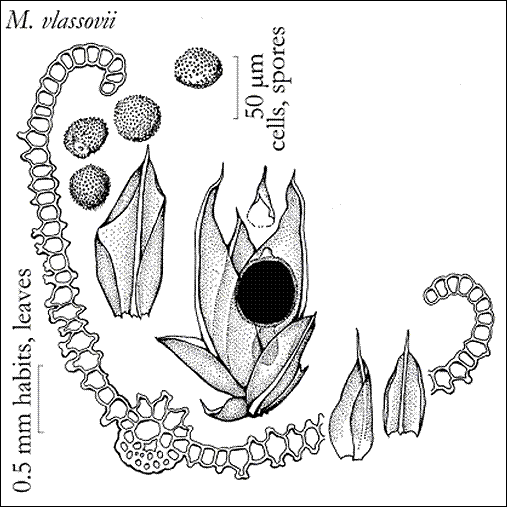Nugget moss (Microbryum vlassovii) COSEWIC assessment and status report: chapter 3
Species Information
Name and classification
Scientific name:
Microbryum vlassovii (Laz.) Zand.
Pertinent synonyms:
Phascum vlassovii Laz.
Common name:
Nugget Moss
Family:
Pottiaceae
Major plant group:
Mosses (Musci)
The Pottiaceae is a large and diverse family of mosses with many of its species restricted to dry environments. It is a challenging family taxonomically and has been undergoing extensive review in recent times (Zander 1993). New genera have been created or the constraints of older genera have been changed to exclude some species and/or include others from different genera. Microbryumvlassovii was previously known as Phascum vlassovii Laz. (McIntosh 1986, 1989). However, Zander (1993) considers Phascum to be polyphyletic and not taxonomically valid. He notes that the genus Microbryum is composed of a group of diminutive species characterized by:
- a single round to semicircular band of thick-walled cells in the central portion of the leaf mid-rib,
- apiculate capsules (spore sacs) when cleistocarpous (spore sacs not having a lid for spore release),
- peristomes (fringes of tooth-like appendages surrounding the mouth of the capsule), when present (they are absent in M. vlassovii), are truncate and relatively large as compared to the capsule, and
- a red KOH reaction in the upper portions of the leaf.
Microbryum vlassovii is one of four species previously included in Phascum in North America (Anderson et al. 1990). The other former species, with changes in brackets (following Zander 1993), are P. cuspidatum Hedw. (= Tortula atherodes Zand.), P. floerkeanum Web. & Mohr (= Microbryum floerkeanum (Web. & Mohr) Schimp.), and P. hyalinotrichum Card. & Thér. (= Stegoniahyalinotricha (Card. & Thér.) Zand.). Tortula atherodes and M. floerkeanum are also found in Canada, with only T. atherodes having a rather widespread distribution, overlapping in its range with M. vlassovii (Ireland et al. 1987; Zander 1999).
Microbryum vlassovii differs from Tortula atherodes (= Phascum cuspidatum) principally by the bottle-shaped extensions of the leaf cells adjacent to the similarly ornamented costa (mid-rib). According to Zander (1993), the leaves of Phascum cuspidatum turn yellow in weak KOH, whereas the leaves of species of Microbryum turn red.
Morphological description
The following description has been derived principally from McIntosh (1986), McIntosh & Paige (2001), and Zander (1993, 1999), and from examination of collections. Figure 1 is a composite illustration from Zander (1999) and shows many of the features discussed below.
Figure 1. Illustration of spores, plant, leaves, and leaf cross-section of Microbryum vlassovii (from Zander 1999; with permission from the illustrator, P.M. Eckel).

Microbryum vlassovii is a small moss, less than 2 mm tall, that grows as erect individuals or small, scattered patches. Mature leaves are light green to yellow- (golden-) green, and are about 1 mm long, ovate to ovate-lanceolate, and usually somewhat concave to prow-shaped above. Leaf margins are strongly recurved to somewhat plane at midleaf, and recurved to plane above. The leaf costa (midrib) is pale brown and often wider near the apex than below, and is excurrent as a long, smooth, and often orange mucro or hair tip (awn), with a long apical cell. The upper surface of the costa is ornamented with distinctive bottle-shaped and papillose (wart-like bumps over the cell surface) cells.
The upper leaf cells are even-sided to somewhat irregular in shape, and range in size from 10–15 µm. These cells, especially adjacent to the costa, are characteristically ornamented with tall, hollow, and papillose projections similar to the surficial costal cells. The marginal leaf cells are occasionally more elongate than the adjacent laminal cells, and usually smooth or, rarely, weakly papillose. Leaf cells are somewhat larger toward the middle of the leaf. The basal leaf cells are short to long-rectangular, thin-walled, and smooth. Its rhizoids, slender filaments that attach the moss to its substratum, bear distinctive unicellular and hemispherical units that may serve as ‘tubers,’ thus acting as vegetative propagules (Zander 1999).
Microbryum vlassovii is autoicous, with both male and female structures present on each plant. Sporophytes, which produce spores, mature in late winter and into the spring, and are immersed in the leaves. A tiny apiculus is present at the top of the capsule. The nearly spherical capsules do not open with a lid in order to release their spores like most mosses. Instead, the capsule wall disintegrates as conditions dry into the summer. Spores range from 18-25 µm in size, and are weakly papillose.
Additional illustrations and keys can be found in McIntosh (1986; 1989, illustrations only) and Savicz-Ljubitzkaja & Smirnova (1970, in Russian).